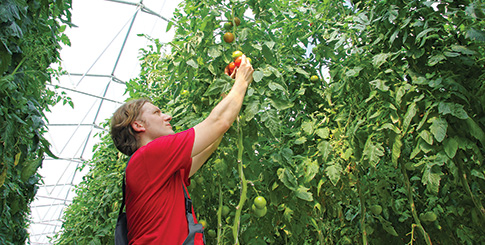Leamington-based Pure Hothouse Foods, Inc. broke ground on a 75-acre greenhouse facility in Georgia last September, while NatureFresh Food Sales not only expanded its Ontario acreage but recently built a greenhouse facility in Ohio. Red Sun Farms, also based in Leamington, has greenhouses in Virginia and Mexico. All chose locations with ample logistics and natural resources, along with economic incentives to help defray startup and operational costs.
Other locations within Canada are competing for new greenhouse acreage too, as provinces across the country build new facilities from British Columbia to Quebec and nearly everywhere in between. Ontario, of course, dominates, but both Quebec and British Columbia have significant acreage, and Alberta isn’t too far behind.
Facts & Figures
The Ontario Greenhouse Vegetable Growers, based in Leamington, offers a host of information about the province’s thriving greenhouse sector. Here are some interesting facts and figures:
• in spite of the greenhouse sector’s worldwide growth, Leamington’s industry continues to shine as it edges closer to a billion dollars in annual farm gate value
• there are 220 licensed and food safety-audited members from across Ontario
• total acreage in Ontario is over 2,700 acres, tended by 13,000 workers
• tomatoes (beefsteak, cherry, cocktail, grape, Roma, and on-the-vine varieties) account for over 36 percent of acreage
• peppers (bell, hot, and mini peppers) account for 35 percent of acreage
• cucumbers (regular-size, mini, and cocktail seedless varieties) account for the remaining 29 percent of acreage
• a whopping 70 percent of production is exported to the United States.Source: Ontario Greenhouse Vegetable Growers, www.ogvg.com.
An added bonus for British Columbia and Quebec is their location, positioned on opposite coasts and, like Ontario, near major metro populations in the United States. As such, their greenhouses can provide product to Canadian and American markets, reducing shipping time and food miles to millions of consumers.
Veillon expects the trend of expanding outside Leamington to continue, because it’s simple math. “The need for more fresh fruit and vegetables is increasing throughout North America; the ability to grow locally is also increasing with the need to reduce food miles.”
Yield vs. Flavor?
For many in the industry, the top attributes of greenhouse production remain a reduction in waste resulting from consistency in yield, color, size, and flavor.
Several innovations are leading the way. First, tinkering with light, natural and artificial, can lengthen the growing cycle and reduce dependence on other markets during off-peak production. Second, using various types of screens can prevent excessive sunlight, and also minimize destructive bugs.



